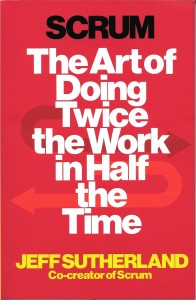The one sentence summary
Small multi-disciplinary teams get things done faster and more effectively than conventional larger structures.
WHAT THE BOOK SAYS 
- This is all about doing twice the work in half the time.
- The Scrum approach reduces team sizes and breaks down projects into short-term goals, allowing constant assessment of progress and an agile, adaptive approach to problem solving.
- Improvements in speed and quality of work can be seen almost immediately.
- Gantt charts, or waterfall process charts, always look pretty but they are always wrong. So don’t waste time designing them.
- The main ingredients of Scrum are:
- Pick a Product Owner – they set priorities about what needs to be done.
- Pick a team – 3 to 9 people with a wide range of skills. 7 is ideal.
- Pick a scrum master – to coach everyone through the process and remove obstacles.
- Create and prioritise a product backlog – a list of everything that needs to be done or made.
- Plan sprints – fixed amounts of time less than a month.
- Make work visible on a scrum board – To Do, Doing, Done.
- Have a daily stand up meeting or scrum – each day, same time, 15 minutes maximum.
- Sprint Demo – the team must demonstrate a working version of what has been done (no work in progress, and anyone can come).
- Sprint retrospective – what went well and what could be done better next time?
WHAT’S GOOD ABOUT IT
- Observe, Orient, Decide, Act.
- Plan, Do, Check, Act.
- Multitasking doesn’t work.
- Half done is not done.
- Working long hours gets less done.
- The map is not the terrain.
- Only plan what you need to do.
- Get better every day and measure it (the Kaizen principle).
- Happiness is autonomy, mastery and purpose.
WHAT YOU HAVE TO WATCH
- The author is an ex-Vietnam pilot, so there is a lot of macho phraseology here, such as Hesitation is death, Change or die, and Demo or die.
